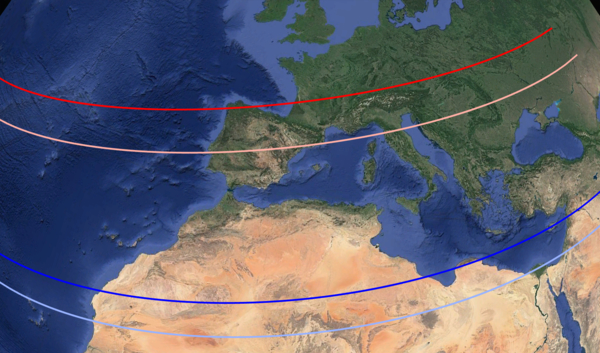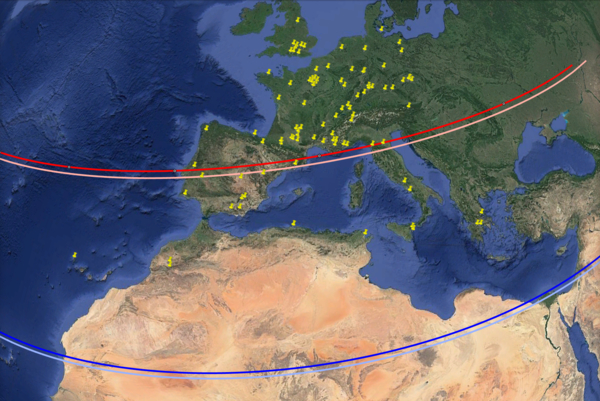Chasing a stellar flash with assistance from Gaia
27 February 2018
Last year, ESA's Gaia mission helped astronomers make unique observations of Neptune's largest moon, Triton, as it passed in front of a distant star. This is a preview of the superb quality and versatility of the Gaia data that will be released in April.| Chasing a stellar flash. (Click here for details and large versions of the video.) Credit: ESA |
When a small Solar System body such as a moon or an asteroid passes in front of a star and temporarily blocks its light, the occultation is an extraordinary chance for astronomers to study the properties of the foreground object. And, of course, the more accurate the prediction of both objects' positions on the sky, the better the observations.
This is why, when a group of astronomers were planning to observe the rare occultation of a distant star by Neptune's moon Triton on 5 October 2017, they made a special request to the Gaia team.
The astronomers, led by Bruno Sicardy from Pierre and Marie Curie University and the Observatory of Paris, France, had used all available observations to compute the path that the moon's shadow would sweep across our planet. Within less than three minutes, the occultation would first cross Europe and North Africa, rapidly moving towards North America.
They knew that somewhere, within this couple of thousand kilometre-wide stretch, would lie a very special thin strip, only about 100-km across. Observers situated on this strip would be perfectly aligned with both Triton and the distant star, and therefore able to see the so-called central flash.
| Central flash during Triton occultation. (Click here for details and large versions of the video.) Credit: Courtesy Rui Gonçalves |
This sharp brightening of the star happens half way through the occultation, and is caused by focussing of the starlight by deep layers in the moon's atmosphere – about 10 km above surface. The central flash contains all-important information to study the profile of Triton's atmosphere and the possible presence of haze in it.
To narrow down the best locations to observe the occultation, and possibly the flash, the astronomers turned to Gaia and its unprecedentedly accurate measurements of the positions of more than a billion stars.
They obtained a first estimate using the star's position from the first batch of Gaia data (Gaia DR1), which were publicly released in 2016. However, knowledge of the star's proper motion – how it moves across the sky over the years – would substantially improve their estimate.
So they approached the Gaia team, asking to receive extra information about the star's motion across the sky from the upcoming second release of Gaia data (Gaia DR2), which is planned for 25 April 2018.
 |
| Improved estimate of the ground trace of Triton occultation. Credit: Google, INEGI, ORION-ME; annotation: ERC Lucky Star project |
Having recognised the importance of these observations, the Gaia team published not only the preliminary position and proper motion of the occulted star from DR2, but also the positions of 453 other stars that could be used to refine the estimate of Triton's orbit. With this additional information, they computed again the location of the thin strip where the central flash would be observed, shifting it roughly 300 km southwards of the earlier prediction.
Come 5 October, a large collaboration of professional as well as amateur astronomers scattered across three continents were ready to observe Triton's occultation at more than a hundred stations.
Almost eighty of them were able to monitor the phenomenon, and the improved prediction of observing locations based on the specially released, preliminary data from Gaia DR2 led to twenty-five successful detections of the central flash, from Spain and Portugal to the south of France and the north of Italy. The astronomers are now busy analysing the data collected during this campaign to learn more about the atmosphere of Triton.
 |
| Observations of Triton occultation. Credit: Google, INEGI, ORION-ME; annotation: ERC Lucky Star project |
This occultation was a rare opportunity to detect possible changes in Triton's atmospheric pressure almost thirty years after the flyby of NASA's Voyager probe in August 1989. Observations of the central flash can also provide unique information to detect possible winds near Triton's surface; current analysis of the data indicates a quiet and still atmosphere.
With the release of the position, parallax and proper motion of more than 1.3 billion stars measured with unprecedented accuracy, Gaia will provide an invaluable resource for all branches of astrophysics. It will also be of great help to professional and amateur astronomers who will be planning the observation of stellar occultations by Solar System bodies in the future, including that of another star by Triton on 6 October 2022.
Notes for editors
The star that was occulted by Triton on 5 October 2017 is UCAC4 410-143659, a 12.7 V-magnitude (12.2 G-magnitude) star, situated in the constellation of Aquarius.
Observations of this occultation by Triton are coordinated by Bruno Sicardy (Université Pierre et Marie Curie and Observatoire de Paris), leader of the ERC Lucky Star project.




